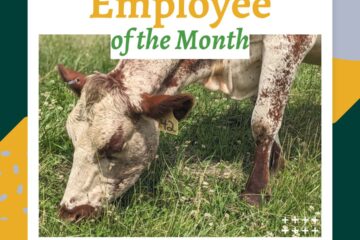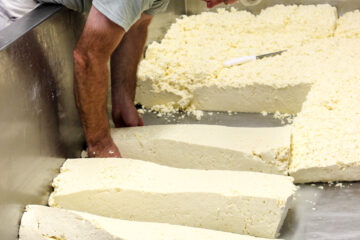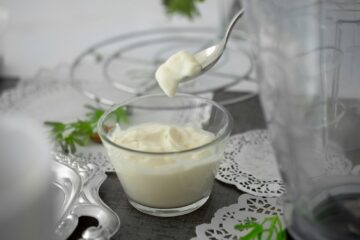The true essence of our cheddar-making at Clover Creek lies in perfectly timing the cooking of those delicate curds to release the whey—a technique that’s become second nature during my tenure as head cheesemaker.
After I cut the curds (see last time’s post), I need to continue to work more whey out of the curds to develop the texture and firmness of the cheese.
The way I do that is by cooking the curds and whey.
Cooking the Curds and Whey
For our cheddar recipe, I heat the vat to 102°F (39°C).
This isn’t a rushed job—I spend 40-60 minutes slowly heating, allowing each tiny curd to shrink and firm up perfectly.
And that whole time I’m stirring the curds, allowing them to bounce off each other and the sides of the vat.
Hand stirring ensures that I’m paying close attention to the cheese vat and carefully controlling the texture development of the curds.
Another 30 minutes of stirring ensures they hit just the right texture and acidity.
When I judge the curds ready, it’s time for the big move.
I want them to feel like wet popcorn.
Not too hard, not too soft, but just right.
Removing the Whey
I push all curds to the sides of our vat and set up the strainer over the drain to catch any curds.
Then I open the drain.
The whey rushes out, cascading into our collection totes outside.
You might think we’re just discarding liquid, but that whey is liquid gold around here.
Our calves love it.
Rich in protein and energy, whey gives them a nutritional boost that keeps them thriving.
Nothing goes to waste on our farm—it’s a perfect cycle.
This separation step does more than just dry out the cheese.
When the whey drains away, it takes much of the milk’s lactose with it.
That’s why our aged cheddars have significantly less lactose than fresh cheese—good news for customers watching their lactose intake.
Other Ways to Use Whey
Some of our fellow cheesemakers take whey utilization even further.
Some turn it into protein supplements others use it for vodka production.
My parents even tried whey soda in Switzerland last year.
Whey’s potential seems endless.
Here at Clover Creek, we’re proud of our simple approach: feeding it back to our animals, closing the loop from farm to cheese and back again.
After draining, I gather all the curds into a central pile, ready for the next crucial step in creating our award-winning cheddar.
But that’s a story for another day.
Next time you taste our cheese, remember: you’re experiencing the result of patience, precision, and our commitment to using every drop of milk’s goodness.
What’s been your favorite part of the process so far?
Let me know in the comments below!



0 Comments